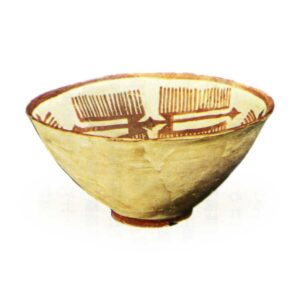
The oldest pottery in the Orient was excavated from the site of Jal in the Tigris River basin, and is estimated to date to between 6,000 and 5,000 B.C. It is made of clay mixed with straw-like sedge. These are pots and bowls made of straw-like straw mixed with soot and decorated with geometrical patterns. The next period, the Hassna period, includes jars with geometric patterns and colorful engravings. From the Saamallah period, there were human and goat patterns, and from the Halaf period, there were various types of earthenware decorated in red, white, and black, with patterns ranging from geometric patterns to animal and bird patterns. In the Ubaid period, the next stage, obvious botanical and animal designs appear. The Iranian Plateau culture was particularly advanced in the development of this type of colored pottery, which is discussed elsewhere. Other notable examples are the use of colored glazed bricks in Assyrian palaces since the 14th century B.C. and in New Babylonian palaces in the late 8th century B.C., where a variety of color combinations were used, including yellow, red, white, and blue. On the other hand, the Anatolian plateau region is home to a prominent Hittite culture, where jugs with beak-type spouts are characteristic. Most of them are glazed reddish-brown and have no design, and the shape is reminiscent of a reclining bird. Most of them have a base, but some have a pointed bottom. The Canaanite culture has existed along the Mediterranean coast since the third millennium B.C., and Ugarit is the most famous of them. The most distinctive feature is a long, narrow jar with a pointed bottom and a large circular handle, with a black geometric pattern on a red slip.



